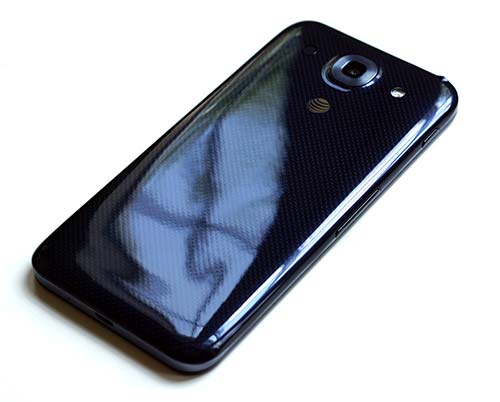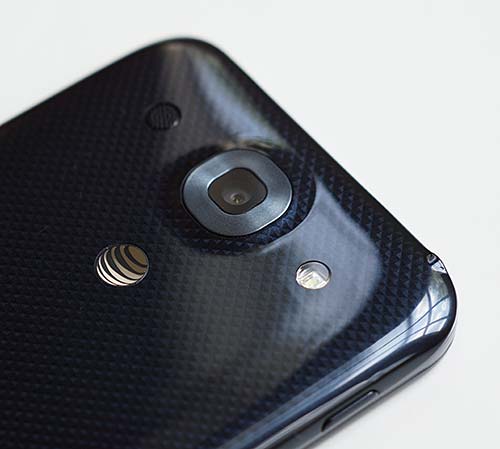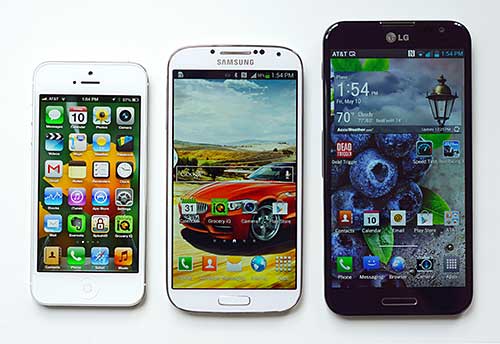Performance and Horsepower
The Optimus G Pro runs on the cutting edge Qualcomm Snapdragon 600 CPU quad core CPU clocked at 1.7GHz, just like the HTC One. It uses Adreno 320 graphics and this is currently the fastest CPU and GPU you can get in a smartphone. That said, as we've seen before, LG's smartphones score a bit lower than the competition in synthetic benchmarks. Can you see or feel the difference? No, because it's faster than the OS and demanding apps like 3D games require.
The phone has 2 gigs of RAM, and that too is cutting edge, so you have plenty of memory for multi-tasking. It has 32 gigs of storage like the non-expandable HTC One, and that's twice the storage you get with the Samsung Galaxy Note 2 and Samsung Galaxy S4 base $199 (with contract) version. Nice. Given how much space today's 3D games require, we'd love to see 32 gigs as the standard on high end smartphones, especially since the OS and pre-installed software eat up 9 gigs of that storage. You can expand storage using microSD cards up to 64 gigs capacity. Keep in mind that you can put videos, music, documents and other data files on microSD cards but you can't install apps on microSD cards with Android 4.0 and newer.
Benchmarks
Quadrant: 11,994
AnTuTu: 18,561
Sunspider: 867
Geekbench 2:2216
| |
Quadrant |
GLBenchmark 2.1Egypt Offscreen |
AnTuTu |
Sunspider JavaScript Test |
| LG Optimus G Pro |
11,994 |
28 fps (GLBench 2.7 used, so results are lower) |
18,561 |
867 |
| Samsung Galaxy Note II |
6001 |
66 pfs (v.2.5 used) |
14,056 |
1052 |
| LG G2 |
19,762 |
57 fps (GLBench 2.7 used, so results are lower) |
32,990 |
823 |
| Samsung Galaxy S4 |
12,276 |
41 fps (GLBench 2.7 used, so results are lower) |
24,776 |
826 |
| HTC One |
12,252 |
37 fps (GLBench 2.7 used, so results are lower) |
24,589 |
1155 |
| Sony Xperia Z |
7916 |
32 fps (GLBench 2.7 used, so results are lower) |
20,403 |
1306 |
| HTC Droid DNA |
7823 |
78 fps (v.2.5 used) |
14,578 |
1146 |
| LG Optimus G |
7235 |
59 pfs (v.2.5 used) |
11,087 |
1289 |
| HTC EVO 4G LTE |
5086 |
56 fps |
7001 |
1650 |
| Motorola Droid RAZR HD |
5055 |
51 fps |
6760 |
1862 |
| HTC One X |
5001 |
56 fps |
7074 |
1617 |
| Samsung Galaxy S III |
5102 |
51 fps |
7011 |
1825 |
Software
The phone runs Android 4.1.2 Jelly Bean with a promised upgrade to 4.2 (also called Jelly Bean since it's not a major update). It has LG's Optimus UI that reminds us of Samsung's TouchWiz, but it's more toned down. The phone supports motion features: turn it face down to silence an alarm or ringer and to pause video, and as with Samsung recent Galaxy phones, it can watch your face to prevent the screen from turning off when you're looking at it. As with other recent LG Optimus Android phones, the G Pro has QSlide for multi-tasking (with only 4 apps), QuickMemo for taking notes and screenshots anywhere and collaboration over the network with other LG Optimus phones. QSlide lets you float the calculator, Note Pad, Calendar and video player in a floating, resizable window. These floating apps have transparency sliders, but you're limited to just 4 apps, which falls short of Samsung's selection of Multi-Window apps.
13 Megapixel Camera
The huge, sharp 1920 x 1080 IPS display and the 13 megapixel rear camera with LED flash and HDR are the Optimus G Pro's biggest selling points. We see improvement here over the 13MP camera on some Optimus G variants from last year, and it takes truly lovely and natural looking photos. Colors are a little overly bold when viewed on a PC monitor, though they might not look it on the phone's display when compared to the Samsung Galaxy S4 or Note II's photos viewed on their super-vibrant Super AMOLED displays. If you're keen on photography, I don't think you'll be disappointed with the G Pro. Is it better than the Nokia Lumia 920 and Samsung Galaxy S4? Not so much; in fact it's a close race. It's certainly good enough to not send me back to those phones when I need to take good photos and 1080p video.
Battery Life
Big phones have room for big batteries, and the LG Optimus G Pro has a relatively huge 3140 mAh battery. That's 40 mAh more than the Samsung Galaxy Note II, but that's not enough added capacity to make a difference. The phone has a very fast but also very power efficient CPU, and Qualcomm's LTE 4G chipsets are now surprisingly power frugal, and that helps the LG power through a full day on a charge easily with moderate use. The screen is the biggest power consumer (that's true of most larger screen smartphones), and driving 1920 x 1080 pixels eats a bit more power compared to lower resolution displays. Our first charge yielded unimpressive runtimes, but after that, the Optimus G Pro showed very good stamina, even when making liberal use of streaming video services and playing 3D games like Real Racing (3D games are merciless when it comes to power consumption). We still found that the Note II lasted 30 minutes longer for actual use time on a full charge, but both phones are tops for battery life thanks to their large batteries.
Conclusion
The LG Optimus G Pro has everything a super-phone should, except Samsung and Apple's glorious reputations and marketing budgets. In fact, I do wonder if this Android smartphone will get all the respect it deserves. It's LG's best Android phone to date, and we're impressed at the rapid progress they show here in both hardware and software. Yes, it could look more chic and elegant, but one could easily say the same of other Android phones. The phone has an excellent full HD IPS display that's viewable outdoors and is particularly well suited for reading text. It also features a very fast CPU, a pleasant UI that adds useful touches without bogging down the phone and a very good 13MP camera.
Websites: wireless.att.com, www.lg.com
Price: $199 with contract, $549 without contract
Related:
Samsung Galaxy Note 2 Review
LG G2 Review
LG Optimus G Review
Samsung Galaxy S4 Review
HTC One Review |




The iPhone 5, Samsung Galaxy S4 and LG Optimus G Pro. |

